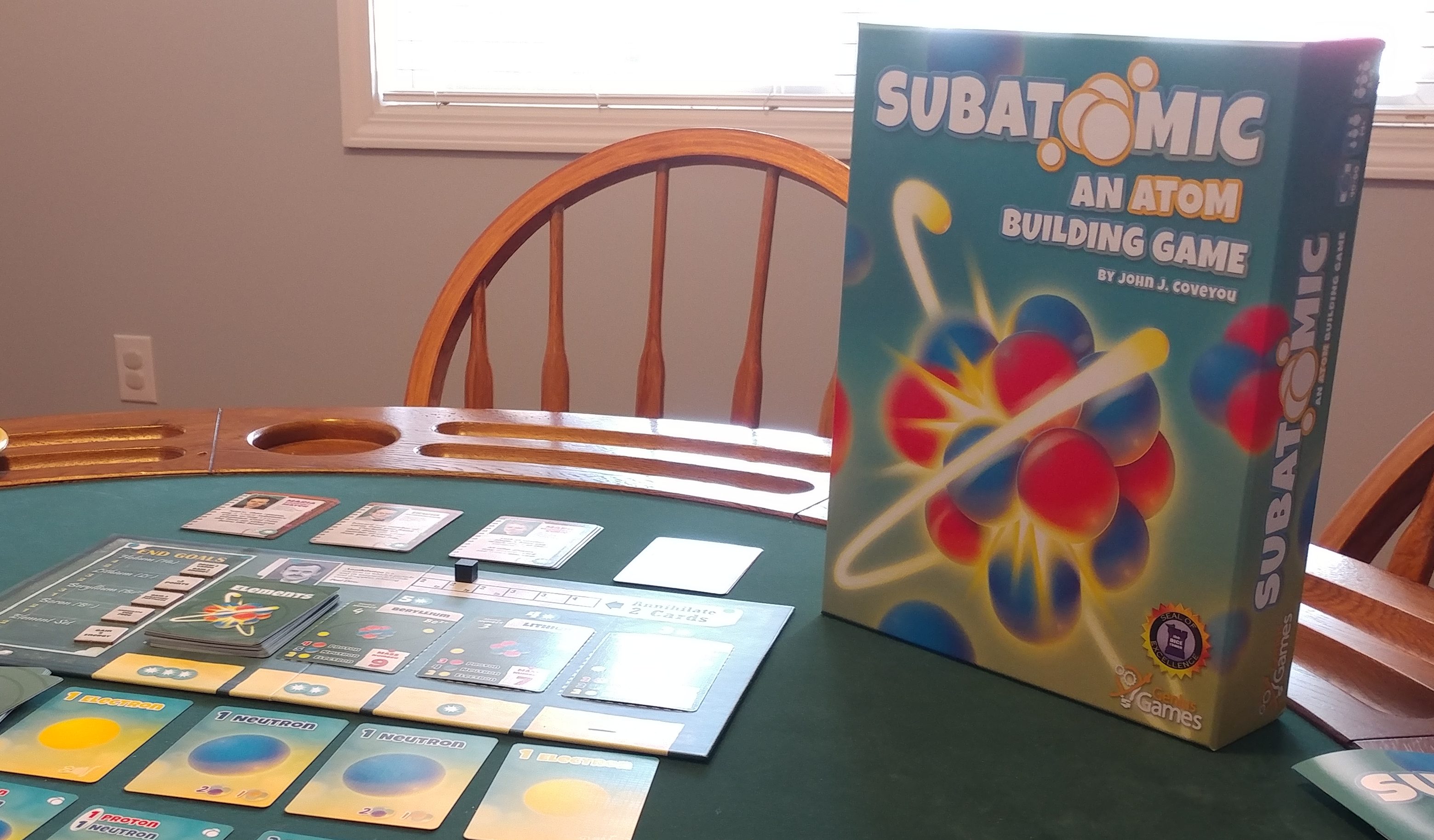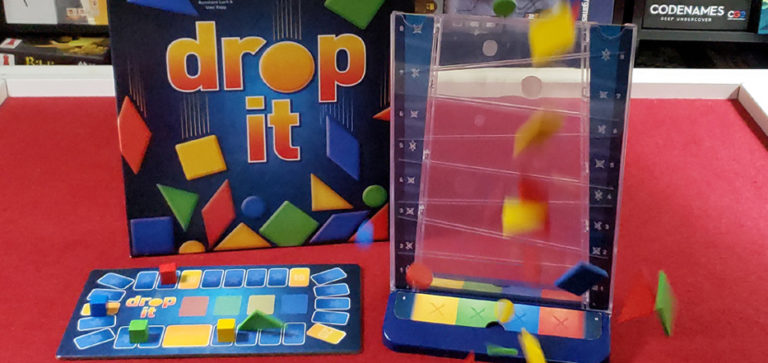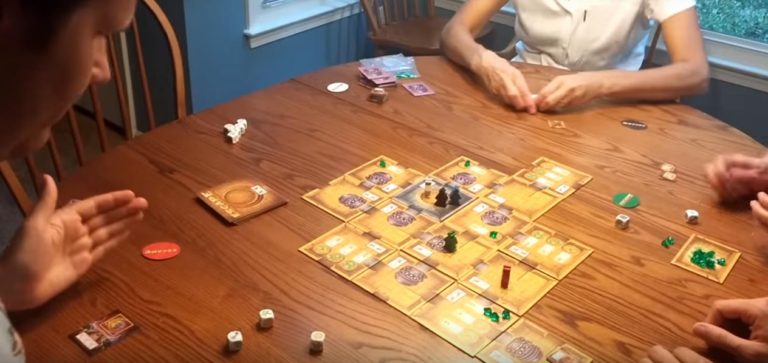As a teacher, I’ve worked pretty hard to find ways to incorporate games into my classroom. I have used Sherlock Holmes: Consulting Detective and the Unlock! series whenever I teach problem solving. We played a modified version of Two Rooms and a Boom as we learned about communication.
While I’ve been able to creatively involve “regular” games into my classes, I’ve always been a bit disappointed with “educational” games. They usually aren’t games as much as trivia contests that reward your knowledge of facts. While I personally excelled at such games in school (my brain can remember all the presidents, but I never know where my keys are), I now understand their limited appeal.
It’s Elemental
Genius Games has sought to rectify this issue with the titles it has released over the past few years. Cellular biology, historical scientists, and more academic-leaning topics can be found in their publication history.
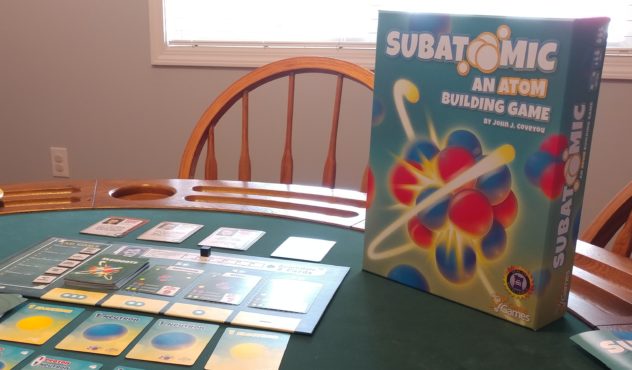
One game that piqued my interest at Origins 2018 was Subatomic, a game designed by John Coveyou in which you use a deck building mechanic to build atoms. I quickly fell in love with the game and have sought to get my hands on it ever since. Now, a few years later, I’ve finally got a copy. But does it hold up?
Little Bitty Pieces
Subatomic is a game all about creating elements. How do you do that? Well, if you’ve taken some science courses, then you already know – by putting protons, neutrons, and electrons together!
The game works like most other deckbuilders – you have a starting deck of relatively weak cards, and throughout the game you’ll use those cards to purchase other, more powerful cards that you will add to your deck, while also working to complete goals that gain victory points.
This game may be the most thematically appropriate deckbuilder yet. You see, you’ll start off with quarks and waves, which you can use to purchase your protons, neutrons, and electrons. You can then use these particles to purchase “upgraded” particles, which are combinations of those three building blocks.
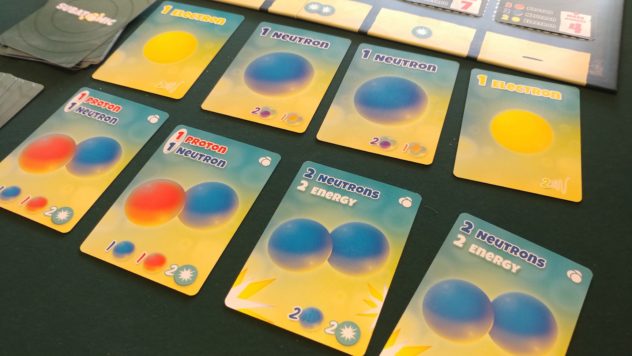
All of these subatomic particles will be used to build elements, which serve as the main source of victory points. Only the first five elements are possible to build, and you’ll need the scientifically accurate number of protons and neutrons to play them. Fortunately, this doesn’t have to happen in one turn. Unlike in many deck builders, you can “save up” between turns, allowing you to make a little progress each round towards your goal.
One aspect of the game I love is that a card is never wasted on a turn. Even if you can’t build up your atom or buy new cards, you can discard a card to gain energy tokens. These are needed to buy certain cards and to pay a variety of costs associated with actions in the game.
Men and Women of Science
You won’t just be working in subatomic particles, though. You’ll also have the ability to buy scientist cards to add to your deck. These cards cost quite a bit of energy, but they can allow you to make really big moves on your turn.
It takes some time to get going in the game, as you’ll want to add better cards to your deck so that you can be more efficient in later rounds. During our playthroughs, it took about 15 minutes before someone got their first element, and another 15 before they got their second. However, towards the end of the game, things start to fly by, and you’ll be desperately trying to pull off just one more big move before someone ends the game by completing their fifth element (no, not the Bruce Willis kind).

Points are scored by the atomic weight of your elements (nice touch!), as well as by the results of the work on a little bonus track. At the end of the game, whoever has the most victory points wins!
The Building Blocks of Matter
Right out the gate, I would say that this is an incredibly thematic game. In most other deck builders, you don’t feel like you’re actually building up to something. For instance, in Dominion, you’re just playing random cards that have random outcomes. Here, you’re actually taking time to construct something. It really is great how well they’ve used this educational concept and really brought it to life in a card game.
The theme also provides a feeling of familiarity for all types of gamers, and I feel like this makes the game more accessible than something like Dominion. Most people understand that you’ve got to put these things together to make an element, so the mechanics come a bit more naturally.
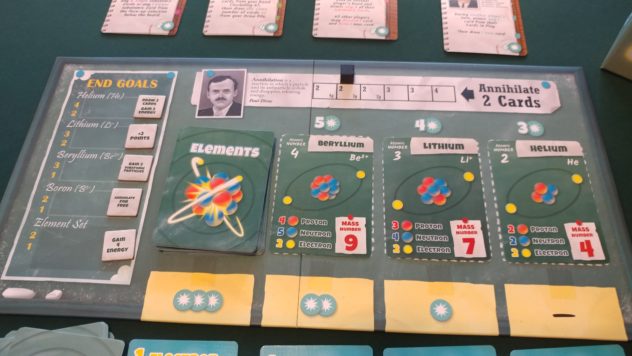
While I do love the theme, I’m a little disappointed that the artwork has changed in the latest edition that was released this year. In the past, each of the subatomic particles had a little cartoonish face that lent a bit of levity to what might be seen as too boring of a concept for a game. Now, the game feels… I dunno, more educational? But not in a way I appreciate. I can understand why they changed it, but I feel that the previous artwork gave the game more character.
Basic Elements
Subatomic is very straightforward in its mechanics. You’ll be playing cards to either buy new things or to build up elements. Many other deck builders have some engine building elements to them, and one of the thrills of gameplay is when you’re able to have an “epic” turn where you make a huge purchase in Dominion or launch a huge attack in Star Realms. You won’t really be doing that here. Aside from a few bonuses from scientist cards, each turn will be the same. You don’t really draw extra cards, and you don’t really take “extra” actions.
Given the lack of options, some more experienced gamers may feel unsatisfied with Subatomic. They may be looking for something “meatier” that allows them to have more control during the game. I can certainly appreciate that sentiment, and I will say that I felt that way around the halfway mark. However, as we approached the end game, things picked up a little bit, and we had an exciting rush to the finish as everyone tried to get that one last purchase.
Positively Charged
It’s difficult to “judge” a game like Subatomic, because I have some conflicting feelings about it. After playing it a couple of times, I will say that it’s not my favorite deck building game out there. However, it does something I haven’t really seen by applying an educational theme to a board game and making it good. This is more than just trivia, and it’s more than just a poorly pasted on theme. You’ll be playing a “for real” board game, and you might be learning along the way.
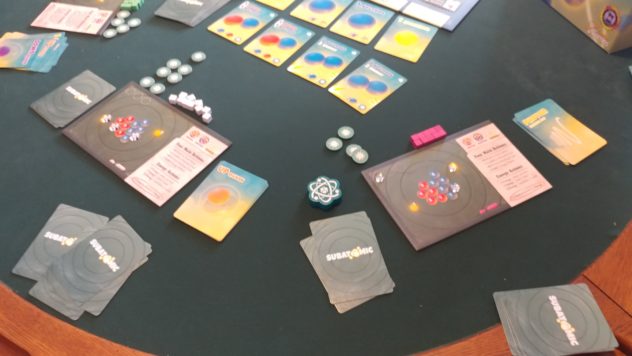
Genius Games is doing something important with games – it’s reclaiming the term “educational” and making it a real board gaming genre again. And for that, they should be applauded. While Subatomic might not be perfect, it’s great to see it out there.
You can purchase a copy of Subatomic from your local game store, from the Genius Games website or on Amazon today.
Genius Games provided us with a retail copy of Subatomic for this review. This in no way influenced our opinion of the game.

